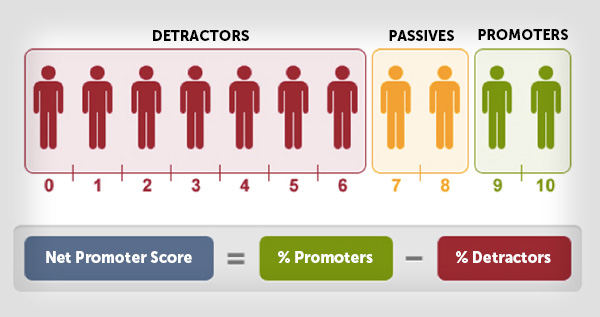15 Guest Satisfaction Survey Terms Demystified

The insights gained from Guest Satisfaction Surveys are invaluable for hoteliers to identify what guests like/dislike and why. By acting quickly and efficiently on this feedback, hotels can deliver service excellence, improve guest satisfaction and positively impact their online reputation.
But does survey jargon leave you perplexed? Do you know your NPS® from your ECR? We've put together a glossary to help you better understand the key terms related to guest surveys and ensure you get the most out of this powerful tool.
ECR (Email Collection Rate)
It is extremely important for hotels to keep track of their Email Collection Rate (ECR) because if you have no emails, how can you contact guests for feedback or other marketing initiatives? ECR is the total number of valid emails a hotel obtains divided by the total number of checkouts. This percentage provides hotel with an idea of how many emails collected were correct, compared to the total number of rooms that checked out of the hotel. It can be a valuable KPI, not only to monitor performance over time, but also to set objectives for staff.
Guest List
For hotels to be able to send a guest survey by email, they need to create a Guest List with relevant data from their PMS, such as guest name, email address and check-out date. The more fields of data included from the PMS, the more detailed the analysis of the survey results can be. For example, if the room number is included then an analysis of guest satisfaction by room number is possible.
Question Logic
Question Logic is a handy feature to use when designing a survey. It allows hoteliers to display or hide questions based upon guest responses, making the survey more relevant to each guest and giving you more detailed feedback to help prioritize operational, service or product related improvements. It also helps you to keep your surveys as short as possible, which is always good for higher response rates!
Using Question Logic, it is possible to create follow-up questions based on the guest's specific answer. For example, rather than ask five questions about check-in, ask one about the overall check-in experience. If guests give a low rating, then ask more questions to gain deeper insight.
Rating Scale
A rating scale is a type of question that requires the guest to assign a value for whatever they are being asked to rate. Three common types of rating scale are numeric, graphic and descriptive.
There are different schools of thought on whether the scale should have an odd or even number of categories. With an odd number of categories such as 1-5, guests are able to select 3 as a neural option. With an even rating scale, there is no middle point, forcing guests to choose a negative or positive option. The number of scale points, as well as whether to use an odd or even number, depends on what sort of question you are asking and what you are hoping to learn from the answers. The scale you choose will be the same for all rating questions throughout the survey.
Likert Scale
The Likert Scale, named after its developer Rensis Likert, is a rating scale used in survey questions to measure the attitudes and opinions of guests. Rather than a simple "yes"/"no" answer, it provides a greater degree of nuance as guests are offered a range of answer options.
Typically, respondents are asked to indicate their level of agreement or disagreement with a statement, based on a five response category scale, ranging from "strongly disagree" to "strongly agree". Alternatively, to measure guest satisfaction, the scale could range from "very dissatisfied" to "very satisfied".
In terms of analysis of the results, it is possible to calculate the percentage of respondents who select each option. If preferred, it is possible to allocate a numerical score to each option and use these values to compute an overall score.
Review Collection Program
Review Collection Programs within guest surveys enable hotels to increase online review volume on leading review sites. Hoteliers who participate in the program can embed a review form into their guest surveys to encourage guests to publish a review online, increasing review volume. Three of the most important programs are offered by TripAdvisor, HolidayCheck and Google.
Post-stay Survey
A post-stay survey is a digital questionnaire sent to guests via email after they check out to evaluate their level of satisfaction with their stay. A series of questions prompt guests to give feedback about specific aspects of their stay as well as to rate departments and attributes. This in-depth feedback provides the hotelier with valuable insights to identify and solve internal issues. It is important to ensure the design of your survey is not overwhelming for the guest whilst allowing the hotel to collect as much detailed feedback as possible.
In-stay Survey
An in-stay survey is sent to guests while they are still on property to check whether they are satisfied with their stay or not. It is an extremely valuable technique as it provides hoteliers with the opportunity to fix any issues identified before the guest checks out, reducing the risk of a negative online review.
This kind of survey is usually short with a maximum of three questions. The channel and timing of sending the in-stay survey can vary depending on the type of hotel. For example, the survey can be sent via email after two nights stay or alternatively using a pop-up with a link to the survey when guests login to the hotel WiFi for the first time.
Delivery Rate
The delivery rate is the percentage of survey emails you send that reach your guest. The metric is calculated by dividing the number of delivered emails, by the total number of emails sent.
A delivered email is a message that arrives correctly in a recipient's inbox without bouncing. A hard bounce reflects a permanent delivery issue such as when the recipient's email address is invalid or the email domain does not exist. A soft bounce typically reflects a temporary delivery issue such as when your email is too large, the server is down or the recipient's inbox is full.
When delivery rates are low, hoteliers can revise their email collection strategy to ensure that emails provided by guests are double checked by front desk staff for example, to increase the volume of emails successfully delivered.
Survey Conversion Rate
The Conversion Rate is simply the percentage of guests who respond to your survey. This is calculated by dividing the number of completed responses to your survey divided by the number of surveys successfully delivered to guests. By optimizing the design and distribution of your survey, it is possible to increase the Conversion Rate.
NPS®
The Net Promoter Score® (NPS) is a customer satisfaction metric based on the fundamental perspective that every company's customer can be divided into one of three categories: promoters, passives or detractors.
It is based on the answer to a simple question within the guest survey "How likely are you to recommend this hotel to a friend or colleague?" Guests are asked to answer this question on a scale of 0 to 10 (which is an 11-point scale).
• Promoters: those giving a score of 9 or 10
• Passives: those giving a score of 7 to 8
• Detractors: those giving a score of 6 or below
To calculate the NPS®, the percentage of detractors is subtracted from the percentage of promoters. That means that this score can be either positive (there are more promoters than detractors) or negative (there are more detractors than promoters).
The NPS® is a standard metric used globally across many industries and its significance continues to grown in the hospitality industry thanks to the standard methodology used making it a key metric for benchmarking.
Overall Satisfaction Score
Overall Satisfaction Score is calculated based the answers to the specific question in the survey asking guests to rate the establishment overall. It is not an average of individual rating questions within the survey related to various elements of their experience. An example of an overall satisfaction question would be "How would you rate your overall experience at the hotel" and responses are given on a numerical scale such as 1-5, 1-6 or 1-10.
Top Box
The Top Box score is a metric that allows you to understand excellence levels at your hotel. It is the sum of the percentages of responses for the top one or two highest points on a rating question.
When hoteliers ask a rating question such as "On a scale of 1-10, how would rate your satisfaction with your bedroom?", they may be particularly interested in how many guests give a score of 9 or 10. The Top Box score allows them to monitor this in an intuitive and easy-to-understand way.
Management Response Rate
Replying to guests who have taken the time to provide feedback in surveys is important to show you care and, when necessary, to state how you are going to follow-up.
Management Response Rate allows hotels to monitor the volume of surveys they respond to. The percentage is calculated based on the total number of surveys you've replied to divided by the number of completed surveys you've received. Hoteliers can monitor the evolution of this metric over time and compare response management response rates for properties within the same group.
Average Response Time
In addition to the volume of survey responses that hoteliers reply to, it is important to monitor how quickly you do this. The average response time, often measured in hours, is an average calculated based on the time it takes management to reply to a guest after receiving the completed survey.
Rather than trying to reply to every guest who provides direct feedback, it is often better to focus on responding as quickly as possible to the most relevant cases. Responding to negative guest feedback tends to take priority over neutral or positive feedback as it often calls for an apology or clarification.
Now that you have an overview of some of the most common guest survey terms, we hope you have a clearer idea of what to consider when developing an effective guest survey strategy. If you would like to see how we can help you improve guest satisfaction at your hotel using direct feedback, from both in-stay and post-stay surveys, please contact us.






